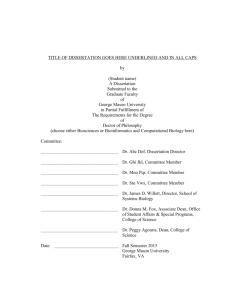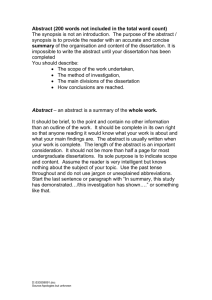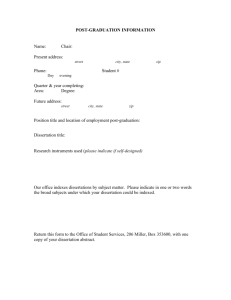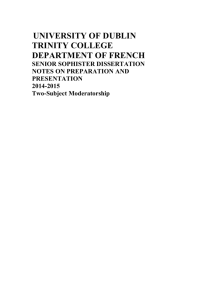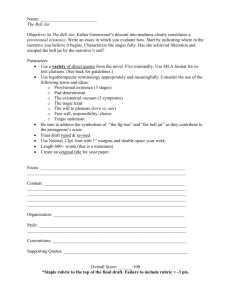Here - Faculty of English Language and Literature
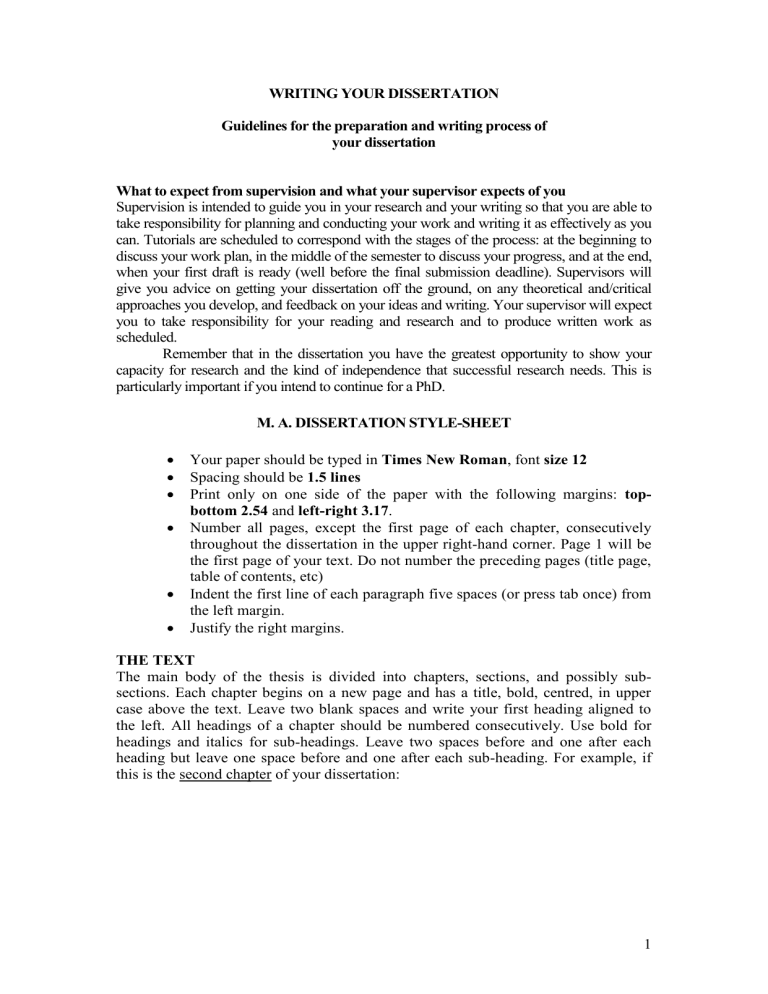
WRITING YOUR DISSERTATION
Guidelines for the preparation and writing process of your dissertation
What to expect from supervision and what your supervisor expects of you
Supervision is intended to guide you in your research and your writing so that you are able to take responsibility for planning and conducting your work and writing it as effectively as you can. Tutorials are scheduled to correspond with the stages of the process: at the beginning to discuss your work plan, in the middle of the semester to discuss your progress, and at the end, when your first draft is ready (well before the final submission deadline). Supervisors will give you advice on getting your dissertation off the ground, on any theoretical and/critical approaches you develop, and feedback on your ideas and writing. Your supervisor will expect you to take responsibility for your reading and research and to produce written work as scheduled.
Remember that in the dissertation you have the greatest opportunity to show your capacity for research and the kind of independence that successful research needs. This is particularly important if you intend to continue for a PhD.
M. A. DISSERTATION STYLE-SHEET
Your paper should be typed in Times New Roman , font size 12
Spacing should be 1.5 lines
Print only on one side of the paper with the following margins: topbottom 2.54
and left-right 3.17
.
Number all pages, except the first page of each chapter, consecutively throughout the dissertation in the upper right-hand corner. Page 1 will be the first page of your text. Do not number the preceding pages (title page, table of contents, etc)
Indent the first line of each paragraph five spaces (or press tab once) from the left margin.
Justify the right margins.
THE TEXT
The main body of the thesis is divided into chapters, sections, and possibly subsections. Each chapter begins on a new page and has a title, bold, centred, in upper case above the text. Leave two blank spaces and write your first heading aligned to the left. All headings of a chapter should be numbered consecutively. Use bold for headings and italics for sub-headings. Leave two spaces before and one after each heading but leave one space before and one after each sub-heading. For example, if this is the second chapter of your dissertation:
1
2. GENDER AND RACIAL DIFFERENCE IN OTHELLO
2.1 Introduction
…………………………………………………………………………………………
………
2.2 Questions of Subjectivity and Ideology
…………………………………………………………………………………………
………
2.3 Historicising Racism
…………………………………………………………………………………………
………
2.3.1 Racism and patriarchy
…………………………………………………………………………………………
………
2.3.2 Racism and sexuality
…………………………………………………………………………………………
………
2.4 Concluding remarks
…………………………………………………………………………………………
…………………………………………………………………………………………
………………………………………………………………
REFERENCES
Remember that when you are using material and ideas that come from the work of others, you need to give proper credit by citing your sources. If you fail to cite a source, whether deliberately or accidentally, you are guilty of plagiarism
– of presenting as your own work the words and ideas of others.
References (in the body of a dissertation or research paper) should document the information or opinion offered, to allow the reader, if s/he wishes to check the evidence on which an argument is based. A reference must, therefore, enable the reader to find the source referred to as quickly and easily as possible. This can be done in the following way:
Incorporate this information in your text, in parentheses ( In-Text Citation ).
References in the text should give the name(s) of the author(s) and the page(s) referred to, or only the page number(s) if the author’s name is mentioned in the sentence incorporating or introducing the quotation. This information is enclosed in brackets. No comma is used between the name and the page number.
2
If more than one source by the same author is being used in the dissertation, then the parenthesis should include a shortened version of the title, followed by the page number. The name of the author should precede the title in the parenthesis only if it is not mentioned in the sentence.
E
XAMPLES OF
I
N
-T
EXT
C
ITATIONS
Human beings have been described as "symbol-using animals" (Burke 3).
. . . as has been discussed elsewhere (Burke 3; Dewey 21).
Wordsworth stated that Romantic poetry was marked by a "spontaneous overflow of powerful feelings" (263).
Romantic poetry is characterized by the "spontaneous overflow of powerful feelings"
(Wordsworth 263).
Wordsworth extensively explored the role of emotion in the creative process (263).
Lightenor has argued that computers are not useful tools for small children ("Too
Soon" 38), though he has acknowledged elsewhere that early exposure to computer games does lead to better small motor skill development in a child's second and third year ("Hand-Eye Development" 17).
Visual studies, because it is such a new discipline, may be "too easy" (Elkins, "Visual
Studies" 63)
ENDNOTES
Because long explanatory notes can be distracting to readers, most academic style guidelines (including the MLA) recommend limited use of endnotes. Footnotes should be avoided. You should use endnotes for evaluative bibliographic comments.
The endnotes should be listed on a separate page titled Notes (no quotation marks or italics), and should appear at the end of each chapter. The notes themselves are listed by consecutive superscript arabic numbers and appear in
1.5 line spacing in regular paragraph format (a new paragraph for each note).
Indent the first line of each note by one tab. Consecutive lines should be flush left.
In the main text, endnotes in MLA format are indicated by consecutivelynumbered superscript arabic numbers appearing after the punctuation of the phrase or clause the note refers to. Numerals in the text should come immediately after that part to which the note refers.
E XAMPLES O F E NDNOTES :
Some have argued that such an investigation would be fruitless.
6
Scholars have argued for years that this claim has no basis, 7 so we would do well to ignore it.
__________________________________
6
On the problems related to repressed memory recovery, see Wollens 120- 35; for a contrasting view, see Pyle.
7
In a 1998 interview, she reiterated this point even more strongly: "I am an artist, not a politician!" (Weller 124).
3
QUOTATIONS
Any quotations you use in your thesis should be convincing and very important. In general, you should do very little direct copying. A dissertation should not consist of a list of quotations. You are expected to gather ideas and passages from your sources, digest them thoroughly, and relate them to your views, always, of course, citing your sources. When you are quoting, quote accurately the wording, spelling, and capitalisation of the original.
For quotations incorporated in your text, use double quotation marks, and for quotations within quotations, single marks.
If you add a word or words in a quotation, you should put square brackets around the words to indicate that they are not part of the original text. For example:
Jan Harold Brunvand, in an essay on urban legends, states: "some individuals [who retell urban legends] make a point of learning every rumor or tale" (78).
If you omit a word or words from a quotation, you should indicate the deleted word or words by using ellipsis marks, which are three periods ( . . . ) each one preceded and followed by a space (no parenthesis or brackets). Do not use ellipsis at the end of a quotation. Make sure that the resulting passage is grammatically complete and correct. For example:
In an essay on urban legends, Jan Harold Brunvand notes that "some individuals make a point of learning every recent rumor or tale . . . and in a short time a lively exchange of details occurs" (78).
To use short quotations (fewer than four typed lines of prose or three lines of verse) in your text, enclose the quotation within double quotation marks.
Provide the author and specific page citation (in the case of verse, provide line numbers) according to the In-Text Citation rules, and include a complete reference on the Works Cited page. Punctuation marks such as periods, commas, and semicolons should appear after the parenthetical citation.
Examples:
According to some, dreams express "profound aspects of personality"
(Foulkes 184), though others disagree.
According to Foulkes's study, dreams may express "profound aspects of personality" (184).
Cullen concludes, "Of all the things that happened there / That's all I remember" (11-12).
Place quotations longer than four typed lines in a free-standing block of text, and omit quotation marks. Start the quotation on a new line, with the entire quote indented 1.5 cm from the left margin; maintain 1.5 line spacing. Indent the first line of the quotation by one tab only if you are citing multiple paragraphs. Your parenthetical citation should come after the closing
4
punctuation mark. When quoting verse, maintain original line breaks. (You should maintain 1.5 line-spacing throughout your essay.)
For Prose quotations :
Nelly Dean treats Heathcliff poorly and dehumanizes him throughout her narration:
They entirely refused to have it in bed with them, or even in their room, and I had no more sense, so, I put it on the landing of the stairs, hoping it would be gone on the morrow. By chance, or else attracted by hearing his voice, it crept to Mr. Earnshaw's door, and there he found it on quitting his chamber. Inquiries were made as to how it got there; I was obliged to confess, and in recompense for my cowardice and inhumanity was sent out of the house. (Bronte 78)
For Poetry quotations :
In her poem "Sources," Adrienne Rich explores the roles of women in shaping their world:
The faithful drudging child the child at the oak desk whose penmanship, hard work, style will win her prizes becomes the woman with a mission, not to win prizes but to change the laws of history. (23-27)
For drama quotations:
A short time later Lear loses the final symbol of is former power, the soldiers who make up his train:
GONERIL. Hear me, my lord.
What need you five-ane-twenty, ten or five,
To follow in a house where twice so many
Have a command to tend you?
REGAN. What need one?
LEAR. O, reason not the need! (2. 4. 254-58)
5
Punctuation with quotations: Periods and commas should be placed before the closing quotation marks. Question marks and exclamation points should appear within the quotation marks if they are a part of the quoted passage but after the parenthetical citation if they are a part of your text; semi-colons that are not part of the quotation should always appear after the closing quotation marks (or after the parenthetical citation, as applicable).
E XAMPLES :
“Poets,” according to Shelley,“ are the unacknowledged legislators of the
World” (794).
“Read ‘Kubla Khan,’” he tells the narrator (36).
“What a wonderful little almanac you are, Celia!” Dorothea Brooke responds to her sister (7).
Is it possible that dreams may express "profound aspects of personality"
(Foulkes 184)?
Works Cited
Basic Rules
A Works Cited list consists only of references included in the text of your dissertation.
Begin your Works Cited page on a separate page at the end of your dissertation.
Label the page Works Cited in bold (do not underline the words Works Cited or put them in quotation marks), and centre the words Works Cited at the top of the page.
List authors/editors alphabetically according to their last name.
Use 1.5 line spacing for all citations, but do not skip spaces between entries.
If an entry runs more than one line, indent the subsequent line (hanging 1.27) from the left margin.
List page numbers of sources efficiently, when needed. If you refer to a journal article that appeared on pages 225 through 250, list the page numbers on your Works Cited page as 225-50.
Capitalize each word in the titles of articles, books, etc, but do not capitalize articles, short prepositions, or conjunctions unless one is the first word of the title or subtitle: Gone with the Wind , The Art of War , There Is Nothing Left to
Lose .
Use italics for titles of larger works (books, Journals) and quotation marks for titles of shorter works (poems, articles).
According to the MLA style, to document a book , write first the last name of the author, followed by a comma and then his/her full first name, followed by a period.
Then write the title of the book, italicized, followed by a full stop; next the place of publication, a colon, the name of the publisher, a comma, and the year of publication.
If you use two or more works by the same author, list each work separately in your final bibliography, but you may not repeat the author’s name. To indicate the omission of the name, use three hyphens followed by a period (---.).
NEW : The 7th edition of the MLA Handbook has introduced significant changes in relation to the documentation of sources. In the past the medium of publication in the works cited list was required only for works in media other than print (e.g . CD-ROM,
6
DVD, etc). Print was considered the default medium and was therefore not listed. The
MLA no longer recognizes print as the default medium and instead demands listing the medium of publication in every entry.
Here are some examples of the most basic entries. For further information and more examples of documentation please check the latest edition (7th, 2009) of the
MLA Handbook for Writers of Research Papers.
Examples (not in alphabetical order):
Books, Edited Volumes, Works in Anthologies, Articles in Journals:
Gleick, James. Chaos: Making a New Science . New York: Penguin Books, 1987.
Print.
Gillespie, Paula, and Neal Lerner. The Allyn and Bacon Guide to Peer Tutoring .
Boston: Allyn, 2000. Print.
Palmer, William J. Dickens and New Historicism . 2 nd
ed. New York: St. Martin's,
1997. Print.
---. The Films of the Eighties: A Social History . Carbondale: Southern Illinois UP,
1993. Print.
Foucault, Michel. Madness and Civilization: A History of Insanity in the Age of
Reason . Trans. Richard Howard. New York: Vintage-Random House, 1988.
Print.
Wellek, Rene. A History of Modern Criticism, 1750-1950 . Vol. 5. New Haven: Yale
UP, 1986. Print. 8 vols. 1955-92. [the shaded supplementary information at the end, about the total number of volumes and their dates of publication, may be added, although not required, if you are using only one volume of a multivolume work]
Hill, Charles A., and Marguerite Helmers, eds. Defining Visual Rhetorics . Mahwah,
NJ: Lawrence Erlbaum Associates, 2004. Print.
Peterson, Nancy J., ed. Toni Morrison: Critical and Theoretical Approaches .
Baltimore: Johns Hopkins UP, 1997. Print.
Harris, Muriel. "Talk to Me: Engaging Reluctant Writers." A Tutor's Guide: Helping
Writers One to One . Ed. Ben Rafoth. Portsmouth, NH: Heinemann, 2000. 24-
34. Print.
Swanson, Gunnar. "Graphic Design Education as a Liberal Art: Design and
Knowledge in the University and The 'Real World.'" The Education of a
Graphic Designer . Ed. Steven Heller. New York: Allworth Press, 1998. 13-
24.Print.
7
More, Hannah. “The Black Slave Trade: A Poem.” British Women Poets of the
Romantic Era . Ed. Paula R. Feldman. Baltimore: Johns Hopkins UP, 1997.
472-82. Print.
Bagchi, Alaknanda. "Conflicting Nationalisms: The Voice of the Subaltern in
Mahasweta Devi's Bashai Tudu." Tulsa Studies in Women's Literature 15.1
(1996): 41-50. Print.
Allen, Emily. "Staging Identity: Frances Burney's Allegory of Genre." Eighteenth-
Century Studies 31 (1998): 433-51. Print.
Perret, Delphine, and Marie-Denise Shelton, eds. Maryse Conde . Spec. issue of
Callaloo 18.3 (1995): 650-790. Print.
Makward, Christiane. “Reading Conde’s Theater.”
Maryse Conde . Ed. Delphine
Perret and Marie-Denise Shelton. Spec. issue of Callaloo 18.3 (1995): 681-89.
Print.
Coetzee, J. M. Introduction. The Confusions of Young Torless . By Robert Musil.
Trans. Shaun Whiteside. New York: Penguin, 2001. v-xiii. Print.
Cross references
To avoid unnecessary repetition in citing two or more works from the same collection you may create a complete entry for the collection and cross-reference individual pieces to the entry.
Example:
Agee, James. “Knozville: Summer of 1915.” Oates and Atwan 171-75.
Atwa, Robert. Foreword. Oates and Atwan x-xvi.
Oates, Joyce Carol, and Robert Atwan, eds. The Best American Essays of the Century .
Boston: Houghton, 2000. Print.
Citing Web Publications
An entry usually contains the following components, in sequence:
1.
Name of the author, compiler, director, editor, narrator, performer, or
translator of the work.
2.
Title of the work (italicized or in quotation marks according to standard rules).
3.
Print publication information (for a work which has also appeared in print).
4.
Title of the overall Web site (italicized), if distinct from item 2.
5.
Version or edition used.
6.
Publisher or sponsor of the site.
7.
Date of publication (day, month, and year, as available).
8.
Medium of publication (Web).
9.
Date of Access (day, month, and year).
8
Examples of Web Publications
Liu, Alan, ed. Home page. Voice of the Shuttle . Dept. of English, U of California,
Santa Barbara, n.d. Web. 15 May 2009.
“The Scientists Speak.” Editorial.
New York Times . New York Times, 20 Nov. 2007.
Web. 15 May 2008.
Cascardi, Anthony J. Ideologies of History in the Spanish Golden Age . University
Park: Pennsylvania Sate UP, 1997. Penn State Romance Studies . Web. 12
Mar. 2007.
“de Kooning, Willem.”
Encyclopaedia Britannica Online . Encyclopaedia Britannica,
2008. Web. 15 May 2008.
Salda, Michael N., ed. The Cinderella Project . Vers. 1.2. U of Southern Mississippi,
Oct. 2005. Web. 15 May 2008.
Child, L. Maria, ed.
The Freedmen’s Book
. Boston, 1866. Google Book Search . Web.
15 May 2009.
Landauer, Michelle. “Images of Virtue.”
Romanticism on the Net 46 (2007): n.pag.
Web. 8 Nov. 2007.
Tolson, Nancy. “Making Books Available.”
African American Review 32.1 (1998): 9-
16. JSTOR . Web. 5 June 2008.
Miller, Steven, and Sara Guyer, eds. Literature and the Right to Marriage . Spec. issue of Diacritics 35.4 (2005): 1-124. Project Muse . Web. 30 Nov. 2007.
France, Anatole. “Pour la Paiz, pour la liberte.” New Age 5 Sept. 1907: 297-98. The
Modernist Journals Project . Web. 30 Nov. 2007.
NEW : The previous MLA Handbook (6 th edition) recommended including URLs of web resources. But this has proved to have limited value for they often change or can be specific to a subscriber or a session etc. You should include a URL as supplementary information only when the reader probably cannot locate the source without it. If you do, present it immediately following the date of access, a period, and a space. Enclose it in angle brackets, and conclude with a period. If it has to be divided between two lines, break it only after the double slashes or a single slash.
Eaves, Morris, Robert Essick, and Joseph Viscomi, eds. The William Blake Archive .
Lib of Cong., 28 Sept. 2007. Web. 20 Nov. 2007.
< http://www.blakearchive.org/blake/ >.
9
A Lecture, Speech, or Conference Presentation
Include the speaker’s name, title of the presentation (if known) in quotes, details about the meeting or event where the presentation was given, including its location and date of delivery. In lieu of a title, label the speech according to its type, e.g.,
Guest Lecture, Keynote Address, State of the Union Address.
Stein, Bob. Keynote Address. Computers and Writing Conference. Union Club Hotel,
Purdue University, West Lafayette, IN. 23 May 2003.
Films and Video Recordings
The Usual Suspects . Dir. Bryan Singer. Perf. Kevin Spacey, Gabriel Byrne, Chazz
Palminteri, Stephen Baldwin, and Benecio del Toro. Polygram, 1995. Film.
Ed Wood . Dir. Tim Burton. Perf. Johnny Depp, Martin Landau, Sarah Jessica Parker,
Patricia Arquette. 1994. Touchstone, 2004. DVD.
If you refer to the film in terms of the role or contribution of a director, writer, or performer, begin the entry with that person's name, last name first, followed by role.
Lucas, George, dir. Star Wars Episode IV: A New Hope . 1977. Twentieth Century
Fox, 1997. Film.
Abstract
The abstract should be no more than a single page and should summarise what has been written/researched in the dissertation. The dissertation should be accompanied by an abstract in both English (before the first page of your text) and Greek (at the end of the dissertation).
Table of Contents
The contents page will indicate the numbering, the titles of all chapters, sections and subsections, and the page in the dissertation where they occur.
Cover page
Please follow the sample below.
Appendices
Appendices should be numbered consecutively and each appendix should have a title.
Any appendices should follow your bibliography. Numbers and titles of appendices should appear in the table of contents.
Proof reading
10
All your work should be carefully proof read before it is handed in. Typographical errors, spelling mistakes etc. make a very bad impression. It is your responsibility to edit your work and to make sure that the language is accurate, and the style appropriate. You will probably need to read the dissertation at least twice in order to be sure of its accuracy. Remember that the quality of your writing is one element that is taken into account in the grading.
Preparing your dissertation for submission
You supervisor will have to approve your final draft, so you will need to hand it in to him/her well before the final submission deadline (your supervisor will indicate to you how much time he/she will need to read your final draft before the final deadline).
Once your final draft has been approved for submission, you will need to make three thermal bound copies of your dissertation: one for your supervisor and two for the second and third readers/assessors. Submit the three copies together with a CD to the secretary’s office no later than the deadline set by the Faculty.
The criteria on the basis of which your papers will be evaluated include the following: focus on the topic under investigation (as given in the title) adequate research and sufficient knowledge and use of relevant material coherence of content with full documentation ability for original critical thought satisfactory presentation (style, grammar, spelling, references in the text) accurate citation of all entries referred to in the text
A very good dissertation will in principle be worthy of reading by a wider specialist audience and contain publishable material. A failed dissertation would be weak on many of the criteria listed above. In addition, plagiarism is a reason for failure (i.e. the presentation of other people’s work as the work of the dissertation writer).
A final note…
Writing your dissertation should be an exciting and demanding exercise. This is the end of your postgraduate studies hence, a great opportunity for following up the areas/issues that interest you. Yet, it can be tough and sometimes you may feel a bit lonely. Remember that your colleagues are also writing dissertations and that exchanging experiences and discussing problems can be a good way to see things more clearly.
Good luck to everyone!
11
University of Athens
Faculty of English Studies
M. A. Programme
Literature, Culture, and Ideology
Title of MA Dissertation
Student’s Name: i.d. number:
Date of Submission:
Declaration: This submission is my own work. Any quotation from, or description of, the work of others is acknowledged herein by reference to the sources, whether published or unpublished.
Signature
12



